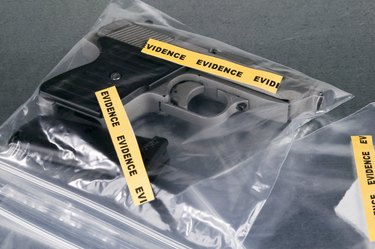
Spectrophotometry is a process commonly used in the field of forensic science to trace evidence. This process uses infrared radiation and more commonly visible lights to ascertain light transmission, absorption, and reflective properties of any form of tiny materials. Otherwise called micro-spectrophotometry, this process uses a microscopic light source analyzer to investigate hair, textiles, and paints that are normally too small to be analyzed by the naked eyes or microscope.
Forensic Science
Video of the Day
Forensic science is the application of scientific knowledge to legal problems. Forensic experts collect evidences at crime scenes and analyze them in sophisticated science laboratories. These procedures have been proven to be very beneficial in identifying criminals as well as protecting the innocent from unjust punishment. Among various scientific tools, spectrophotometer plays an important role in recognizing materials and ascertaining the nature of such evidence.
Video of the Day
Process
Chemical bonds within the molecular components of various forms of organic and inorganic matters interact with and respond to light in characteristic ways. As these molecules absorb rays emitted from a spectrophotometer, they will transmit and reflect frequencies under infrared light. Any particular piece of hair or cloth will have specific visible properties. Spectrophotometry enhances the ability to make a color visible while determining its composition.
Importance
Spectrophotometry is an extremely important tool in forensic science because the success of any criminal investigation largely depends on forensic science, which requires specifics and details regarding any particular facet of science. Understanding a specific item's detailed and fundamental composition assists in determining the brand, manufacturing, and location of any particular trace element that could link numerous other facets of a crime together. While in use, spectrophotometry allows for highly detailed and conclusive results for any product being analyzed.
Procedures
In forensic science, when using spectrophotometry, any particular trace element is inserted into a microscope and is then exposed to a varied array of visible and infrared frequencies. When observable frequencies are available, they are recorded and tracked as a detector, which acts as a kind of basic fingerprint of that particular item. These trace samples are stored for future observation or use.
Design
Two different variations of a spectrophotometry machine are used in forensic science: single and double beam. A double beam machine compares light densities between two different paths whereas the single beam takes a sample point of reference for comparison. Single beam spectorphotometry units are usually much more dynamic and widely used in that they provide a wide range of light sources while making the readings much simpler and more compact. Numerous variations of this machine exist with the base model consisting of a monochromator (i.e., a device for isolating a narrow portion of a spectrum) with a diffraction grating to analyze the actual infrared lighting sources for accurate and reliable results.